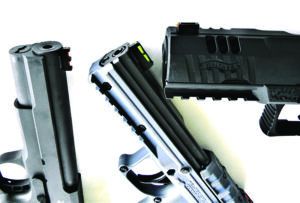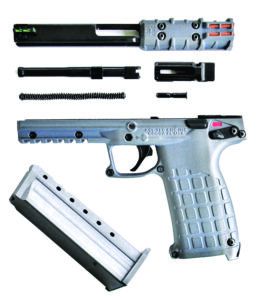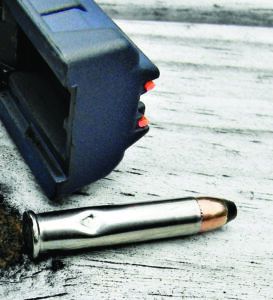The 22 Winchester Magnum Rimfire has enjoyed steady popularity since its introduction 65 years ago. The 22 WMR, or 22 Magnum, is a crackerjack cartridge that increases the range and killing power of a rimfire firearm. The cartridge differs considerably from the 22 Long Rifle. The hoary old 22 LR features a lead heel-based bullet pressed into the case. The 22 Magnum features a jacketed bullet crimped into the cartridge case. This makes the Magnum much more feed reliable. The 22 Magnum has been adapted to revolvers easily, but the cartridge has not been chambered in self-loading pistols as seamlessly. A rimmed cartridge case presents a design hurdle. Most 22 Magnum loads are designed for rifles and use slower-burning powder, with the Hornady Critical Defense round used in this test being an exception. As a result, the cartridges often leave considerable powder residue.
Three modern handguns we tested in this chambering recently were the KelTec PMR-30 PMR30TACGY in Tactical Grey coloring, $490; the Rock Island Armory XT 22 51996, $503; and the Walther WMP (Walther Magnum Pistol) 5220300, $549. All make claim to perfect reliability and good accuracy. They actually came very close, but only one exhibited perfect reliability.
How We Tested
We expanded the test program over our usual two to four loads. We usually use some type of FMJ loading for practice and a hollow point to confirm feed reliability, then proceed to a mix of three loads for accuracy testing from a benchrest. We used a total of 10 loads during this test. The loads used are listed in the Velocity Table as a point of interest, as well as the usual Range Data.
We wanted to test reliability with inexpensive FMJ loads, which are usually more lightly loaded, to the most potent loads and high-velocity offerings with 30-grain bullets as well as heavier 45-grain class loads. We used six CCI, one Winchester, one Armscor, and two Hornady loads. We also included some results from a 6½-inch-barrel revolver we recently tested for comparison, and, finally, we chronographed a rifle using 22 Magnum loads. The self-loading handguns generate significantly greater velocity than revolvers, we found. Handguns and velocity with high-intensity loads are unpredictable, and while similar handguns may post similar velocities, it isn’t always a given. The Walther seemed to generate the highest velocity with most loads, but then the Rock gave a 92-fps boost over the Walther with one load — from the same box of ammunition used to test the Walther. The Walther definitely generates more velocity than most revolvers. The revolvers tested with 22 Magnum loads were 6½-inch barrel handguns, the longest practical field length. As one rater noted, he will retire his Ruger Single Six from small-game hunting in favor of the Walther. The Walther, he feels, is like a rifle on the hip. All agree that in a pinch the 22 Magnum could be a life saver if you can shoot well, much more so than a revolver with only six rounds on tap.

All three makers stress properly loading the magazines is important for 22 Magnum feed reliability. We used the same drill when loading all three pistols. We slipped the long cartridges under the feed lips, and after loading three rounds, we tapped the back of the magazine to seat the cartridges fully to the rear. We also did not lower the follower to its lowest point and drop cartridges in. We pressed them in one at a time. The Walther WMP’s polymer magazine is easily loaded to full capacity, the best of the test in that regard, despite its lower round count.
The power of the cartridge, while respectable, isn’t something we recommend for personal defense, but we recognize many shooters will consider these guns for self defense regardless. Their better use, in our view, is as a field gun for small game and protection against feral dogs and bobcat-size pests. It compares well against the 32 H&R Magnum or 380 ACP for the recoil shy. The bottom line must be reliability, and the design of the cartridge itself is a problem. Rimfire cartridges are notorious for the occasional failure to ignite the priming compound. We ran a thorough test of the three guns with nine types of 22 Magnum ammunition for a total of 800 cartridges, spread out as evenly as possible among the three handguns. We liked all of the guns, but one had troubling function problems. Another was a bit large for most hand sizes. But one of this trio we recommend wholeheartedly, for the reasons we list below.
Gun Tests Grade: A (BEST BUY)
$490
The PMR-30 has been out the longest of the three handguns and still appears futuristic in profile. The pistol looks to be a full-size handgun like the others; however, the KelTec is feather-light at only 13.8 ounces. The pistol’s loaded weight is less than 19 ounces, below the empty weight of the other two pistols, despite the KelTec’s 30-round magazine, giving the pistol part of its name. The PMR-30 is supplied with two of these long, but relatively thin, pistol magazines.
| Action Type | Single Action |
| Overall Length | 7.9 in. |
| Overall Height | 5.5 in. |
| Maximum Width | 1.1 in. |
| Weight Unloaded | 13.8 oz. |
| Weight Loaded | 17.8 oz. |
| Slide | Grey Cerakote steel |
| Slide Retraction Effort | 12.0 lbs. |
| Receiver Material | Grey Zytel and aluminum alloy |
| Front Strap Height | 3.8 in. |
| Rear Strap Height | 2.8 in. |
| Barrel Length | 4.3 in. |
| Grip Panels | None, alligator pattern grips |
| Grip Thickness | 1.0 in. |
| Grip Circumference | 5.6 in. |
| Magazines | (2) 30 round |
| Rear Sight | Fixed Hi-Viz fiber optic |
| Front Sight | Fiber optic |
| Trigger Pull Weight | 3.15 lbs. |
| Trigger Span | 2.6 in. |
| Sight Radius | 5.6 in. |
| Safety | Manual |
| Warranty | Lifetime |
| Telephone | (321) 631-0068 |
| Website | KeltecWeapons.com |
| Made In | U.S.A. |
The PMR-30’s operating action is among the most interesting features. While it is blowback operated, KelTec tells us the pistol operates as a delayed-blowblack mechanism, depending on the pressure curve of the cartridges. As we learned during the test fire, there are several pressure levels of 22 Magnum ammunition, with 40-grain loads spanning a velocity of 1259 to 1421 fps. The barrel free floats in the receiver. If lower-power ammunition is used, the pistol operates as a simple blowback. If higher pressure loads adhere to the chamber wall in a more aggressive manner, the pistol becomes a delayed blowback style. In fact, it’s almost a locked breech as the cartridge action causes the slide and barrel to remain locked for a longer period, until pressure abates. The Walther operates in a similar manner. Still, the KelTec is reliable with a wide range of 22 Magnum ammunition.

The magazine catch is a heel type, unusual in modern production. It isn’t difficult to use and holds the magazine in place securely. Speed loads are not on the agenda with this type of pistol, especially with 30 rounds in the magazine. Just the same, it isn’t that slow, and the magazine is secure. The frame isn’t made of polymer; rather, it’s a glass-reinforced nylon called Zytel, which has proven to be rugged.
The barrel and slide are steel. Some of the frame is aluminum alloy. The pistol features dual extractors. Considering the problems encountered with the XT 22, this seems a good design feature. The sights are Hi-Viz fiber optics. With two red posts in the rear and a green dot on the front post, we rated these sights the best of the test. The safety is ambidextrous, locking the trigger, and the pistol features an optics-ready slide and a light rail. A rater noted that the safety and magazine release are ambidextrous, a good feature. When the pistol is at rest and uncocked, the safety cannot be applied. Once the slide is racked to the rear, the safety may be applied. This allows loading the pistol with the gun on Safe, with the slide to the rear and locked in place. Insert a loaded magazine, release the slide, and you are loaded and on Safe.
The trigger action is among the best features of the handgun. The trigger has minimal take-up and breaks cleanly at 3.15 pounds. This is easily the best trigger action of the test. The press is crisp and reset sharp.
Disassembly isn’t difficult after the first go-round. Clear the pistol of any ammunition and the magazine. Leave the pistol cocked, or the hammer will impede field stripping. Knock out the takedown pin and push the upper slide, barrel, and recoil assembly out. Pushing the recoil assembly out is practically impossible, despite clear instructions. But pressing a sharp screwdriver into the end of the recoil assembly just under the chamber makes disassembly much easier. After the first time at it, disassembly went smoothly. Not as easy as the Walther by any means, but not difficult.

Loading the magazine to 20 rounds for the first few magazines is recommended as a break in. Loading to 20 rounds is no more difficult than loading the other magazines to full capacity. We thought the Walther was the easiest to load to full capacity, but the Walther’s full capacity is 15 cartridges. But then loading the KelTec to 25 represents a little more difficulty. Some of the raters managed 30 rounds, but most stopped at 27. The magazines provide impressive feed reliability. The pistol never failed to feed and never failed to crack the rimfire primer. Velocities were the lowest of the test but not that low, and the PMR-30 has the shortest barrel. Firing offhand, we were surprised to find the KelTec PMR-30 has some recoil. Not unpleasant, but the pistol actually moves when it is fired. The angular grip, with its alligator-like surface, is comfortable and offers a good gripping surface.
The PMR-30 provided excellent results on the combat firing range. Groups were well centered. The groups were not quite as small as the Walther’s, but they were comparable to the XT 22’s — very good indeed. Fired for accuracy from the bench, the KelTec pistol exhibited excellent accuracy. Groups were smaller than the XT 22’s, but not quite as small as the larger and heavier Walther pistol. We fired all of the 22 Magnum cartridge bullet weights we had obtained in the KelTec, and it ran flawlessly. Worthy of note is that KelTec warns not to use foreign 22 Magnum ammunition. The overseas case walls are thinner and may crumple on feeding. An Armscor cartridge did exactly that, getting a big dent when we attempted to feed it as the first cartridge in the magazine. We cleared the cartridge and placed it in the chamber and dropped the slide. Then we inserted a magazine loaded with 24 rounds of Armscor 40-grain 22 Magnum cartridges. All fired without any misfeeds. This isn’t a recommended load, but it is often the least expensive on the shelf. Don’t complain if it doesn’t feed.
Our Team Said: The KelTec PMR-30 is the only pistol that did not fail to fire at least once, and while we really can’t count that against the Walther, it happened. The KelTec feeds everything, and even the non-recommended load worked fine. We feel that the light weight, ready accuracy, good handling and reliability of the PMR-30 make it a good choice. Not to mention 30-round magazines, even if loaded to only 25 rounds. Also, it features easy red-dot mounting and an accessory rail. We did not notice any loss in speed with the heel-type magazine release. In our view, the KelTec PMR-30 is a Best Buy.
22 WMR (22 Magnum) Range Data
We fired groups at 25 yards from a solid benchrest position using an MTM CaseGard K-Zone Shooting Rest. We used a Competition Electronics Pro Chrony to measure velocity. We placed the front screen of the chronograph 10 feet from the muzzles of the firearms.| Winchester Super-X 40-grain FMJ | Walther WMP | Rock Island Armory XT22 | KelTec PMr-30 |
| Average Velocity | 1260 fps | 1282 fps | 1249 fps |
| Muzzle Energy | 141 ft.-lbs. | 146 ft.-lbs. | 139 ft.-lbs. |
| Small Group | 1.1 in. | 2.0 in. | 1.6 in. |
| Average Group | 1.8 in. | 2.4 in. | 2.3 in. |
| CCI Maxi-Mag 40-grain JHP | Walther WMP | Rock Island Armory XT22 | KelTec PMr-30 |
| Average Velocity | 1421 fps | 1382 fps | 1330 fps |
| Muzzle Energy | 179 ft.-lbs. | 170 ft.-lbs. | 157 ft.-lbs. |
| Small Group | 1.5 in. | 1.8 in. | 1.6 in. |
| Average Group | 2.0 in. | 2.5 in. | 2.0 in. |
| Hornady Critical Defense 45-grain FTX | Walther WMP | Rock Island Armory XT22 | KelTec PMr-30 |
| Average Velocity | 1254 fps | 1293 fps | 1235 fps |
| Muzzle Energy | 157 ft.-lbs. | 167 ft.-lbs. | 152 ft.-lbs. |
| Small Group | 1.7 in. | 2.1 in. | 1.8 in. |
| Average Group | 2.1 in. | 2.6 in. | 2.2 in. |
Additional 22 WMR (22 Magnum) Velocity Data
| Load | Walther WMP | Rock Island Armory XT22 | KelTec PMR-30 |
|---|---|---|---|
| CCI VNT 30 grain | 1490 fps | 1433 fps | 1409 fps |
| CCI V-Max 30 grain | 1516 fps | 1550 fps | 1477 fps |
| CCI TNT 30 grain | 1568 fps | 1660 fps | 1498 fps |
| CCI Game Point 40 grain | 1401 fps | 1366 fps | 1345 fps |
| Armscor JHP 40 grain | 1310 fps | 1274 fps | 1299 fps |
Comparative 22 WMR (22 Magnum) Velocity
We used a Competition Electronics Pro Chrony to measure velocity. We placed the front screen of the chronograph 10 feet from the muzzles of the firearms.| Hornady V-Max | CZ 512 Rifle | Walther | Rock Island Armory | KelTec |
| 30-grain 83202 | 20.5-inch Barrel | WMP | XT 22 | PMR-30 |
| Average Velocity | 2371 fps | 1522 fps | 1539 fps | 1498 fps |
| CCI Maxi-Mag | CZ 512 Rifle | Walther | Rock Island Armory | KelTec |
| 40-grain JHP | 20.5-inch Barrel | WMP | XT 22 | PMR-30 |
| Average Velocity | 2260 fps | 1421 fps | 1382 fps | 1330 fps |
| Hornady Critical Defense | Heritage Revolver | Walther | Rock Island Armory | KelTec |
| 45-grain FTX | 6.5-inch Barrel | WMP | XT 22 | PMR-30 |
| Average Velocity | 1160 fps | 1254 fps | 1293 fps | 1235 fps |
| CCI Maxi-Mag | Heritage Revolver | Walther | Rock Island Armory | KelTec |
| 46-grain Segmented HP | 6.5-inch Barrel | WMP | XT 22 | PMR-30 |
| Average Velocity | 1201 fps | 1299 fps | 1257 fps | 1242 fps |

























